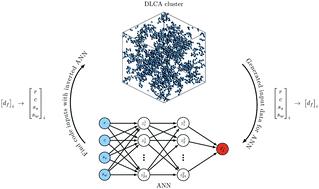当前位置:
X-MOL 学术
›
Soft Matter
›
论文详情
Our official English website, www.x-mol.net, welcomes your
feedback! (Note: you will need to create a separate account there.)
Machine learning-based structure–property predictions in silica aerogels
Soft Matter ( IF 2.9 ) Pub Date : 2021-06-30 , DOI: 10.1039/d1sm00307k Rasul Abdusalamov 1 , Prakul Pandit , Barbara Milow , Mikhail Itskov , Ameya Rege
Soft Matter ( IF 2.9 ) Pub Date : 2021-06-30 , DOI: 10.1039/d1sm00307k Rasul Abdusalamov 1 , Prakul Pandit , Barbara Milow , Mikhail Itskov , Ameya Rege
Affiliation

|
The structural features in silica aerogels are known to be modelled effectively by the diffusion-limited cluster–cluster aggregation (DLCA) approach. In this paper, an artificial neural network (ANN) is developed for predicting the fractal properties of silica aerogels, given the input parameters for a DLCA algorithm. This approach of machine learning substitutes the necessity of first generating the DLCA structures and then simulating and characterising their fractal properties. The developed ANN demonstrates the capability of predicting the fractal dimension for any given set of DLCA parameters within an accuracy of R2 = 0.973. Furthermore, the same ANN is subsequently inverted for predicting the input parameters for reconstructing a DLCA model network of silica aerogels, for a given desired target fractal dimension. There, it is shown that the fractal dimension is not a unique characteristic defining the network structure of silica aerogels, and the same fractal dimension can be obtained for different sets of DLCA input parameters. However, the problem of non-uniqueness is solved by using a guided gradient descent approach for predictive modelling purposes within certain bounds of the input parameter-space. Model DLCA structures are generated from the constrained and unconstrained inversion, and are compared against several parameters, amongst them, the pore-size distributions. The constrained inversion of the ANN is shown to predict the DLCA model parameters for a desired fractal dimension within an error of 2%.
中文翻译:

基于机器学习的二氧化硅气凝胶结构-性能预测
众所周知,二氧化硅气凝胶的结构特征可以通过扩散限制簇-簇聚集(DLCA)方法进行有效建模。在本文中,给定 DLCA 算法的输入参数,开发了一种人工神经网络 (ANN) 来预测二氧化硅气凝胶的分形特性。这种机器学习方法取代了首先生成 DLCA 结构然后模拟和表征它们的分形特性的必要性。开发的 ANN 展示了在R 2的精度内预测任何给定 DLCA 参数集的分形维数的能力= 0.973。此外,对于给定的所需目标分形维数,随后将相同的 ANN 反转以预测用于重建二氧化硅气凝胶 DLCA 模型网络的输入参数。在那里,表明分形维数不是定义二氧化硅气凝胶网络结构的唯一特征,并且对于不同的 DLCA 输入参数集可以获得相同的分形维数。然而,非唯一性问题是通过使用引导梯度下降方法在输入参数空间的某些范围内进行预测建模来解决的。模型 DLCA 结构由约束和无约束反演生成,并与几个参数进行比较,其中包括孔径分布。
更新日期:2021-07-23
中文翻译:

基于机器学习的二氧化硅气凝胶结构-性能预测
众所周知,二氧化硅气凝胶的结构特征可以通过扩散限制簇-簇聚集(DLCA)方法进行有效建模。在本文中,给定 DLCA 算法的输入参数,开发了一种人工神经网络 (ANN) 来预测二氧化硅气凝胶的分形特性。这种机器学习方法取代了首先生成 DLCA 结构然后模拟和表征它们的分形特性的必要性。开发的 ANN 展示了在R 2的精度内预测任何给定 DLCA 参数集的分形维数的能力= 0.973。此外,对于给定的所需目标分形维数,随后将相同的 ANN 反转以预测用于重建二氧化硅气凝胶 DLCA 模型网络的输入参数。在那里,表明分形维数不是定义二氧化硅气凝胶网络结构的唯一特征,并且对于不同的 DLCA 输入参数集可以获得相同的分形维数。然而,非唯一性问题是通过使用引导梯度下降方法在输入参数空间的某些范围内进行预测建模来解决的。模型 DLCA 结构由约束和无约束反演生成,并与几个参数进行比较,其中包括孔径分布。











































 京公网安备 11010802027423号
京公网安备 11010802027423号